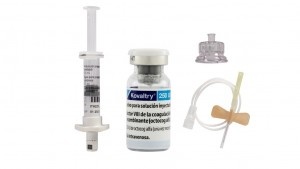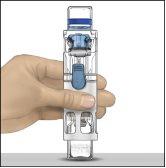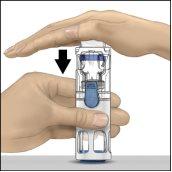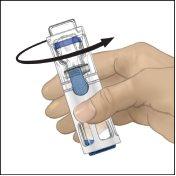

ADYNOVI 250 IU / 2 mL POWDER AND SOLVENT FOR INJECTABLE SOLUTION

Ask a doctor about a prescription for ADYNOVI 250 IU / 2 mL POWDER AND SOLVENT FOR INJECTABLE SOLUTION

How to use ADYNOVI 250 IU / 2 mL POWDER AND SOLVENT FOR INJECTABLE SOLUTION
Introduction
Package Leaflet: Information for the User
ADYNOVI250UI/2ml powder and solvent for solution for injection
ADYNOVI500UI/2ml powder and solvent for solution for injection
ADYNOVI1000UI/2ml powder and solvent for solution for injection
rurioctocog alfa pegol (pegylated recombinant human coagulation factor VIII)
This medicinal product is subject to additional monitoring, which will allow for the quick identification of new safety information. You can help by reporting any side effects you may get. The last section of the leaflet includes information on how to report side effects.
Read all of this leaflet carefully before you start using this medicine, because it contains important information for you.
- Keep this leaflet, you may need to read it again.
- If you have any further questions, ask your doctor.
- This medicine has been prescribed for you only. Do not pass it on to others, as it may harm them, even if their symptoms are the same as yours.
- If you get any side effects, talk to your doctor. This includes any possible side effects not listed in this leaflet. See section 4.
Contents of the pack
- What is ADYNOVI and what is it used for
- What you need to know before you use ADYNOVI
- How to use ADYNOVI
- Possible side effects
- Storage of ADYNOVI
- Contents of the pack and other information
1. What is ADYNOVI and what is it used for
ADYNOVI contains the active substance rurioctocog alfa pegol, pegylated human coagulation factor VIII. The human coagulation factor VIII has been modified to prolong the duration of its action. Factor VIII is necessary for blood to form clots and to stop bleeding. In patients with haemophilia A (congenital lack of factor VIII), it is either not present or does not work properly.
ADYNOVI is used for the treatment and prevention of bleeding in patients from 12 years of age with haemophilia A (a hereditary bleeding disorder caused by the lack of factor VIII).
2. What you need to know before you use ADYNOVI
Do not use ADYNOVI:
- if you are allergic to rurioctocog alfa pegol, octocog alfa or any of the other ingredients of this medicine (listed in section 6)
- if you are allergic to mouse or hamster proteins
If you are unsure, consult your doctor.
Warnings and precautions
Consult your doctor before starting treatment with ADYNOVI.
There is a very small risk that you may experience an anaphylactic reaction (a severe, sudden allergic reaction) to ADYNOVI. You should be aware of the early signs of allergic reactions, such as rash, urticaria, hives, generalised itching, swelling of the lips and tongue, difficulty breathing, wheezing, chest tightness, feeling of general discomfort and dizziness. These could be symptoms of anaphylactic shock. Other symptoms may include severe dizziness, loss of consciousness and great difficulty breathing.
If any of these symptoms occur, stop the injection immediately and consult your doctor. Severe symptoms, such as difficulty breathing and (near) fainting, require urgent treatment.
If you have any heart disease, inform your doctor, as there is a higher risk of complications due to blood clot formation.
Patients who develop factor VIII inhibitors
The formation of inhibitors (antibodies) is a known complication that can occur during treatment with all factor VIII medicines. These inhibitors, especially in large quantities, prevent the treatment from working properly, so you and your child will be carefully monitored for the development of such inhibitors. If your bleeding or your child's bleeding is not being controlled with ADYNOVI, consult your doctor immediately.
Catheter-related complications
If you need to use a central venous catheter (CVC), you should be aware of the risk of complications related to the device, such as local infections, presence of bacteria in the blood and thrombosis in the catheter area.
Children and adolescents
ADYNOVI can only be used in adolescents and adults (aged 12 years and older). The warnings and precautions mentioned also apply to adolescents.
Other medicines and ADYNOVI
Tell your doctor if you are using, have recently used or might use any other medicines.
Pregnancy and breastfeeding
If you are pregnant or breastfeeding, think you may be pregnant or are planning to have a baby, ask your doctor for advice before using this medicine. Haemophilia A rarely affects women. Therefore, there is no experience with the use of ADYNOVI during pregnancy and breastfeeding.
Driving and using machines
ADYNOVI has no influence on the ability to drive and use machines.
ADYNOVI contains sodium
This medicine contains 0.45 mmol of sodium (10 mg) per vial. This should be taken into account in patients on a low-sodium diet.
3. How to use ADYNOVI
Treatment with ADYNOVI will be started and supervised by a doctor experienced in the treatment of patients with haemophilia A.
Your doctor will calculate your dose of ADYNOVI based on your condition and body weight and whether it is used for prevention or treatment of bleeding. The frequency of administration will depend on how ADYNOVI works in your case. Replacement therapy with ADYNOVI is usually a lifelong treatment.
Follow exactly the administration instructions for this medicine given by your doctor. If you are unsure, consult your doctor again.
Prevention of bleeding
The usual dose of ADYNOVI is 40 to 50 IU per kg body weight, administered twice a week.
Treatment of bleeding
The dose of ADYNOVI is calculated based on your body weight and the desired factor VIII levels. The factor VIII levels to be achieved will depend on the severity and location of the bleeding.
Consult your doctor if you think the effect of ADYNOVI is insufficient.
Your doctor will perform the necessary laboratory tests to ensure that you have the appropriate factor VIII levels. This is especially important if you are going to undergo major surgery.
Use in children and adolescents
ADYNOVI can only be used in adolescents and adults (aged 12 years and older). The dose for adolescents is also calculated based on body weight and is the same as for adults.
How ADYNOVI is administered
ADYNOVI is usually injected into a vein (intravenously) by a doctor or nurse. You or any other person can also administer the injection of ADYNOVI, but only after receiving proper training. The detailed instructions for self-administration are described at the end of this leaflet.
If you use more ADYNOVI than you should
Follow exactly the administration instructions for ADYNOVI given by your doctor. Consult your doctor if you are unsure. If you inject a higher dose of ADYNOVI than recommended, consult your doctor as soon as possible.
If you forget to use ADYNOVI
Do not inject a double dose to make up for forgotten doses. Administer the next injection as scheduled and continue as instructed by your doctor.
If you stop treatment with ADYNOVI
Do not stop using ADYNOVI without consulting your doctor.
If you have any further questions on the use of this medicine, ask your doctor.
4. Possible side effects
Like all medicines, this medicine can cause side effects, although not everybody gets them.
If you experience severe, sudden allergic reactions (anaphylaxis), stop the injection immediately. Contact your doctor immediatelyif you experience any of the following initial symptoms of allergic reactions:
- rash, urticaria, hives, generalised itching,
- swelling of the lips and tongue,
- difficulty breathing, wheezing, chest tightness,
- feeling of general discomfort,
- dizziness and loss of consciousness.
Severe symptoms, such as difficulty breathing and (near) fainting, require urgent treatment.
In patients who have received previous treatment with factor VIII (more than 150 days of treatment), inhibitor antibodies may be formed (see section 2) with a low frequency (less than 1 in 100 patients). If this happens, the medicine you are taking may stop working properly and you may experience persistent bleeding. In this case, contact your doctor immediately.
Common side effects(may affect up to 1 in 10 people)
Headache, nausea, diarrhoea, rash
Uncommon side effects(may affect up to 1 in 100 people)
Flushing, allergic reaction (hypersensitivity)
Factor VIII inhibitors (for patients who have received previous treatment with factor VIII (more than 150 days of treatment))
Other side effects in children
The frequency, type and severity of adverse reactions in children are expected to be the same as in adults.
Reporting of side effects
If you experience any side effects, talk to your doctor, even if they are not listed in this leaflet. You can also report side effects directly via the national reporting system listed in Appendix V. By reporting side effects, you can help provide more information on the safety of this medicine.
5. Storage of ADYNOVI
Keep this medicine out of the sight and reach of children.
Do not use this medicine after the expiry date which is stated on the label and carton after EXP. The expiry date is the last day of the month stated.
Store in a refrigerator (2°C to 8°C).
Do not freeze.
Keep the blister in the outer packaging to protect from light.
During its validity period, the powder vial can be stored at room temperature (up to 30°C) for a single period not exceeding 3 months. In this case, the medicine expires at the end of this 3-month period or on the expiry date printed on the product vial, whichever comes first. Please note on the packaging the date of the end of the 3-month storage period at room temperature. The medicine must not be refrigerated again after storage at room temperature. Do not refrigerate the medicine after preparation.
Use the medicine within 3 hours after complete dissolution of the powder.
This medicine is for single use only. Dispose of any unused solution properly.
Medicines should not be disposed of via wastewater or household waste. Ask your pharmacist how to dispose of medicines no longer required. This will help protect the environment.
6. Container Contents and Additional Information
Composition of ADYNOVI
- The active substance is rurioctocog alfa pegol (human coagulation factor VIII produced by recombinant DNA technology). Each vial of powder contains nominally 250, 500 or 1000 IU of rurioctocog alfa pegol.
- The solvent contains 2 ml of sterile water for injectable preparations.
- The other ingredients are mannitol, trehalose dihydrate, histidine, glutathione, sodium chloride, calcium chloride dihydrate, tris(hydroxymethyl)aminomethane, polysorbate 80 and sterile water for injectable preparations. ADYNOVI contains sodium, see section 2.
Appearance and Container Contents of the Product
ADYNOVI is supplied as a powder and solvent for solution for injection. The powder is a white to off-white powder that crumbles. The solvent is a clear, colorless solution. After reconstitution, the solution is clear, colorless and free of foreign particles.
Marketing Authorization Holder
Baxalta Innovations GmbH
Industriestrasse 67
A-1221 Vienna
Tel: +44(0)1256 894 959
Email: [email protected]
Manufacturer
Baxalta Belgium Manufacturing SA
Boulevard René Branquart 80
B-7860 Lessines
Belgium
Date of Last Revision of this Leaflet:
Detailed information on this medicinal product is available on the European Medicines Agency website: http://www.ema.europa.eu/
Instructions for Preparation and Administration
ADYNOVI should not be mixed with other medicines or solvents.
It is strongly recommended to record the name and batch number of the product each time ADYNOVI is administered. The blister pack has labels that can be removed.
Instructions for Reconstitution
- Do not use after the expiry date stated on the labels and carton.
- Do not use if the blister pack is not perfectly sealed.
- Do not refrigerate the medicine after preparation.
- If the medicine is still in the refrigerator, remove the sealed blister pack (containing the pre-assembled powder and solvent vials in the reconstitution system) and wait for it to reach room temperature (between 15°C and 25°C).
- Wash your hands with soap and warm water.
- Open the ADYNOVI blister pack by removing the cap. Remove the BAXJECT III system from the blister pack.
- Place the powder vial on a flat surface with the solvent vial on top (Figure 1). The solvent vial has a blue stripe. Do not remove the blue protector until instructed to do so later.
- While holding the powder vial with one hand in the BAXJECT III system, press the solvent vial firmly with the other hand until the system is fully contracted and the solvent enters the powder vial (Figure 2). Do not tilt the system until the transfer is complete.
- Check that the solvent transfer is complete. Gently shake until all the material has dissolved (Figure 3). Check that the powder is completely dissolved; if not, the reconstituted solution will not pass through the filter of the device. The medicine dissolves quickly (usually in less than 1 minute). After reconstitution, the solution should be clear, colorless and free of foreign particles.
Figure1 | Figure2 | Figure3 |
|
|
|
Instructions for Injection
During administration, an aseptic technique is required (in clean and germ-free conditions).
Important Note:
- Examine the prepared solution for particles or color changes before administration (the solution should be clear, colorless and free of particles).
Do not use if the solution is not completely clear or the product is not fully dissolved.
- Remove the blue protector from the BAXJECT III device. Do not introduce air into the syringe. Connect the syringe to the BAXJECT III. It is recommended to use a Luer-lock syringe.
- Hold the system upside down (with the powder vial on top). Withdraw the reconstituted solution into the syringe by slowly pulling the plunger out.
- Disconnect the syringe, connect a butterfly needle to the syringe and inject the reconstituted solution into a vein. The solution should be administered slowly, at a rate determined by the patient's level of comfort, not exceeding 10 ml per minute. (See section 4 "Possible Side Effects").
- Dispose of unused solution properly.
-----------------------------------------------
This information is intended only for healthcare professionals:
On-demand Treatment
In the case of the following bleeding episodes, factor VIII activity should not be below the given plasma activity level (in % of normal or IU/dl) during the corresponding period. The following table can be used as a dosage guide in surgery and bleeding episodes:
Table1Dosage Guide for Bleeding Episodes and Surgery | ||
Severity of Bleeding/Surgical Procedure | Required Factor VIII Level (% or IU/dl) | Dose Frequency (hours)/Duration of Treatment (days) |
Bleeding | ||
Early hemarthrosis or muscle or oral bleeding. | 20 – 40 | Repeat injections every 12 to 24 hours. At least 1 day, until the bleeding episode is resolved, based on pain, or until healing occurs. |
More extensive hemarthrosis, muscle bleeding or hematoma | 30 – 60 | Repeat injections every 12 to 24 hours for 3-4 days or more until acute pain and disability are resolved. |
Potentially life-threatening bleeding. | 60 – 100 | Repeat injections every 8 to 24 hours until the risk disappears. |
Surgery | ||
MinorIncluding dental extraction | 30 – 60 | Every 24 hours for at least 1 day, until healing occurs. |
Major | 80 – 100 (pre- and post-operative) | Repeat injections every 8 to 24 hours until the wound heals adequately and then continue treatment for at least another 7 days to maintain a factor VIII activity of 30% to 60% (IU/dl). |
Prophylaxis
For long-term prophylaxis, the recommended dose is 40 to 50 IU of ADYNOVI per kg of body weight twice a week at intervals of 3 to 4 days. Dose adjustments and administration intervals may be considered based on achieved factor VIII levels and individual bleeding tendency (see section 5.2).
Pediatric Population
The dosage for on-demand treatment in pediatric patients (12 to 18 years of age) is the same as for adult patients. Prophylactic treatment for patients 12 to <18 years is the same as for adult patients. long-term safety of adynovi in children under 12 has not been established. dose adjustments and administration intervals may be considered based on achieved factor viii levels individual bleeding tendency (see section 5.2).< p>
- Country of registration
- Active substance
- Prescription requiredYes
- Manufacturer
- This information is for reference only and does not constitute medical advice. Always consult a licensed doctor before taking any medication. Oladoctor is not responsible for medical decisions based on this content.
- Alternatives to ADYNOVI 250 IU / 2 mL POWDER AND SOLVENT FOR INJECTABLE SOLUTIONDosage form: INJECTABLE, 1,000 IUActive substance: coagulation factor VIIIManufacturer: Takeda Manufacturing Austria AgPrescription requiredDosage form: INJECTABLE, 1500 IUActive substance: coagulation factor VIIIManufacturer: Takeda Manufacturing Austria AgPrescription requiredDosage form: INJECTABLE, 1000 IU - after reconstitution in 2 ml of water for injections, the dose is 500 IU/mlActive substance: coagulation factor VIIIManufacturer: Takeda Manufacturing Austria AgPrescription required
Alternatives to ADYNOVI 250 IU / 2 mL POWDER AND SOLVENT FOR INJECTABLE SOLUTION in other countries
The best alternatives with the same active ingredient and therapeutic effect.
Alternative to ADYNOVI 250 IU / 2 mL POWDER AND SOLVENT FOR INJECTABLE SOLUTION in Poland
Alternative to ADYNOVI 250 IU / 2 mL POWDER AND SOLVENT FOR INJECTABLE SOLUTION in Ukraine
Online doctors for ADYNOVI 250 IU / 2 mL POWDER AND SOLVENT FOR INJECTABLE SOLUTION
Discuss dosage, side effects, interactions, contraindications, and prescription renewal for ADYNOVI 250 IU / 2 mL POWDER AND SOLVENT FOR INJECTABLE SOLUTION – subject to medical assessment and local rules.

















